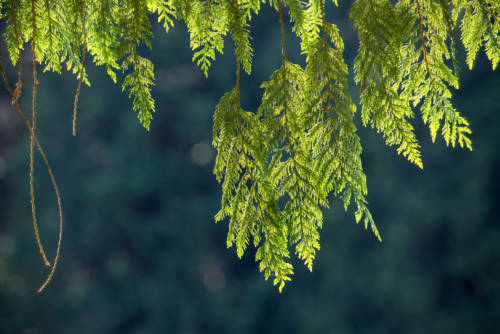Understanding Culturally Modified Trees: The Archeological Treasures of the Lil’wat Nation
“If you take just a little bit of bark from the tree, it heals over and continues to live. Our people are of the land, which offers us everything we need to survive. In turn, it’s our job to protect the forest, the water, and the animals.” – Alison Pascal of the Lil’wat Nation
Hidden deep in the forests of British Columbia lies the scarred bark of culturally modified cedars, physical proof of a practice that once sustained the First Nations people of British Columbia, Canada. A “culturally modified tree” is one that’s been altered by First Nations people as part of their traditional use of the forest. Harvesting cedar bark was a big part of the Lil’wat people’s daily life, and was a practice that held and continues to hold spiritual and practical importance within the native peoples’ daily lives.
To take a closer look at the significance of culturally modified trees, Garden Collage recently spoke with Alison Pascal of the Lil’wat Nation, a First Nations people that hail from the southern Coast Mountains region of the Interior of British Columbia, Canada.
The Lil’wat (L̓il̓wat7úl) Nation
“Where I’m from, our people are called ‘Ucwalmícw,’ which means ‘the people of the land,’” Pascal told us, when speaking of her native environment. “The land is an extension of our home.”
The Lil’wat Nation has 2,500 members and is one of 11 communities that form the Státimc Nation, a territory that spans from Rubble Creek to the coastal inlets of the Pacific Ocean. According to the Squamish Lil’wat Cultural Centre, the Lil’wat Nation is described as “the people of the Srap7úl, the ‘real tree,’ which is the Douglas fir—the tree that grows the highest.”
The Douglas fir tree was historically used as a burial site for the Lil’wat people. When it grows to its fullest, the great Douglas fir was believed to bring Lil’wat ancestors closer to their creator. The Douglas fir was an important tree for the Lil’wat people, but cedar trees also held particular significance.
Culturally Modified Trees
A culturally modified tree is one that’s been altered by First Nations people as part of their traditional use of the forest. Harvesting cedar bark was a big part of the Lil’wat people’s daily life and was a practice that held spiritual and practical importance.
In Alison’s community, elders would harvest bark from a living tree in the springtime and use the bark for clothing, hats, rope, and mats.
“We aren’t as connected to the land as we once were. We can easily go out and buy food; we don’t have to grow it, harvest it, or preserve it anymore. I think it’s important to strive for balance, to think beyond the immediate moment, and to understand how our actions impact other people and things.”
“A culturally modified tree usually refers to red or yellow cedar trees,” Pascal says. “A long time ago, someone discovered that if you take just a little bit of bark from the tree, it could heal over and continue to live. We believe that you should only take what you need and use everything you take, so we didn’t need to kill cedar trees every year.”
“After you’ve taken the bark, you have this long triangular shape from the tree where you can see that the bark has been removed. Just like a cut on your skin, it heals over in time, and you’re left with a scar. That’s what a culturally modified tree is.”
On Healing, Balance & Perspective
Culturally modified trees mirror an important set of beliefs and provide evidence of how the First Nations people used the land. For the Lil’wat Nation, the struggle to protect sacred culture, land, and natural resources has left deep wounds, much like the scarred bark of the great cedars.
These wounds will heal in time, but there will always be evidence of what was taken and what must be protected.
“When I was a teenager, I visited the trails in Stein Valley, BC, an area that’s filled with sacred places for our people to reconnect with the land and their own spirit. The trails have waterfalls and rivers running through them, and there are many places along the river where you can just sit and contemplate. The forest is such a beautiful, peaceful place.”
The Lil’wat Nation has fought long and hard to protect the forests and land that they hold dear. To preserve old-growth forests that were slated for clear-cutting, the Lil’wat people even partnered with environmental groups to protest the government.
According to Alison, culturally modified trees provide evidence that an area is used by First Nations people, who have a great respect and reverence for the forest.
The Spirit of Giving & Taking
Before harvesting cedar bark, the Lil’wat people say a blessing to thank the tree. For Alison’s people, it’s important to make sure the spirit of giving and the spirit of taking are always in balance. The Lil’wat people value cedar trees and the health of the forest as a whole.
“Taking bark from a tree is similar to how you would treat a cut on your skin: you have to give it time to heal,” Pascal continues. “Sometimes that means just leaving it alone and letting the healing process take over. We do the same thing with the forest. If we see an area that’s been harvested recently, we avoid that whole area.”
Alison believes that balancing give-and-take is important, especially in modern times.
“We aren’t as connected to the land as we once were. We can easily go out and buy food; we don’t have to grow it, harvest it, or preserve it anymore. I think it’s important to strive for balance, to think beyond the immediate moment, and to understand how our actions impact other people and things.”
That’s a lesson we can all take to heart.





































